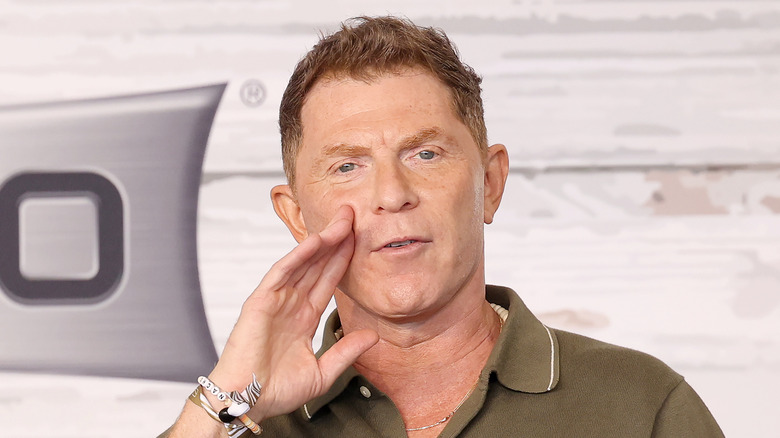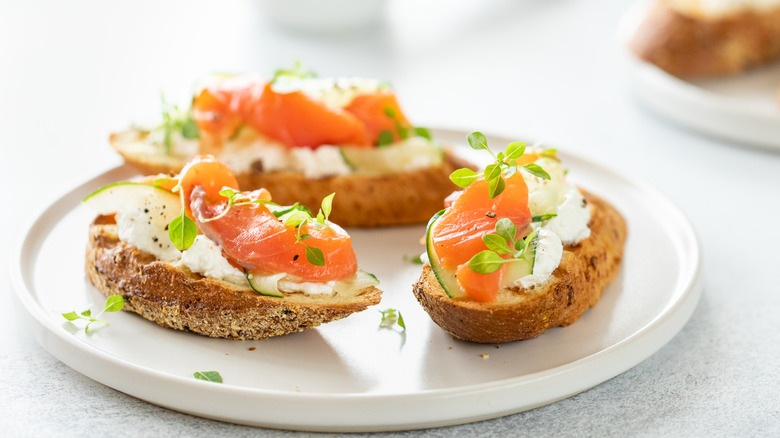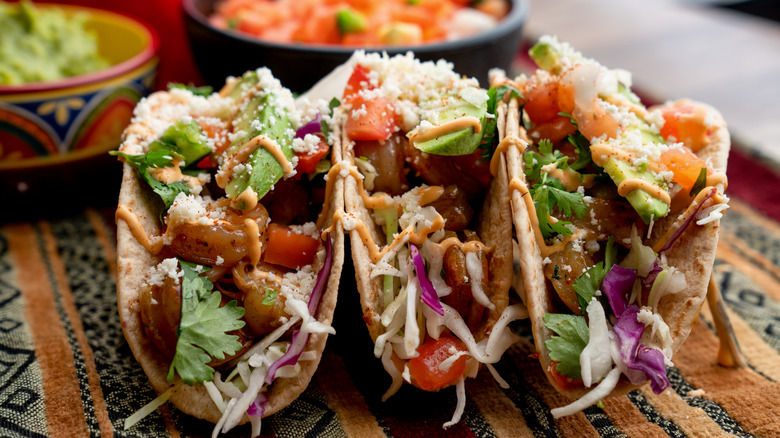Why You're Wrong About Fish And Cheese, According To Bobby Flay
In the culinary world, matching cheese and fish is seen by many (including Padma Lakshmi) as a bit of a faux pas. Some even consider it one of the biggest mistakes you can make when cooking fish. Bobby Flay, however, marches to the beat of his own drum. The chef and TV personality has strong feelings about the practice, and he thinks you should reconsider the controversial pairing for your kitchen. Flay's message for the haters? He doesn't believe there should be an "across-the-board" ban on using the two types of ingredients together.
On Instagram, the "Beat Bobby Flay" host explained that he's not big on stringent rules when it comes to cooking, though he admits that cheese and seafood don't always work together. Ultimately, it depends on the recipe and the ingredients used. "These hard fast rules are crazy. Taste it. Get in there. Be a good cook," he advises his audience. To Flay, "it makes perfect sense" to mix fish and dairy "sometimes." In fact, he claims that numerous high-end chefs have dishes that pair the two.
Of course, Flay notes that it's important to select the right cheese for your fish dish. Good thing he has plenty of experience with this notorious combination of ingredients.
How Bobby Flay uses cheese in his seafood dishes
Leave it up to Bobby Flay to put his spatula where his mouth is. Throughout his career, he's experimented with this combination in plenty of exciting and creative ways. As he noted on Instagram, it's all about finding cheese that complements the fish you're cooking with. He's incorporated feta cheese in a relish, mixed with olive and oregano to accompany grilled red snapper. Crumbly feta is salty but still subtle enough that it won't overpower fish — its zippy creaminess can boost the brininess of canned seafood as well. Flay has also incorporated cheese into his side dishes, making an asparagus cheese puff filled with nutty manchego to go with bold, fatty salmon cooked until crispy.
Of course, anyone who has been to a New York appetizing or bagel shop likely knows that smoked salmon and cream cheese are an iconic duo. Flay has his own take on the combination as the topping for an open-faced omelet, except he infuses the spreadable dairy product with fresh lemon and dill for an extra flavorful, herbaceous zing.
There are certain combinations that Flay wouldn't recommend, though, like cheddar cheese and lobster. Some of the best cheeses that work with seafood, in his opinion, are slightly salty and dry. He explained, "A beautiful Parmigiano Reggiano cheese or Pecorino cheese. It's like, salty. It's dry cheese." If Flay is such a fan of putting seafood and cheese together, why don't more chefs do the same?
Why fish and cheese is considered a no-go
Bobby Flay isn't the first to discover that cheese and seafood work together in some interesting and complex ways. Chefs have been using dairy and seafood together in their creations for ages. Take the traditional Chilean dish machas à la parmesana, for instance, which combines baked clams, wine, butter, cream, and Parmesan cheese to rave results; creamy crab dip (whether with real crab or imitation crab) is another great example. And, of course, there's pizza with anchovies and fish tacos sprinkled with grated cotija.
So what gives? The aversion to eating fish and cheese can be traced back to Italy, where it's very much considered a culinary sin. "Italians are very religious about mixing cheese and fish or seafood, it just isn't done," Julia della Croce told Atlas Obscura. One possibility is that cooks in famous Italian farming and cheese-producing areas like Piedmont and Trentino-Alto Adige weren't used to seafood since they were far from the coast.
Another theory asserts that combining seafood and cheese went against the tenets of humorism, an antiquated approach to medicine developed by Hippocrates that was popular across the Mediterranean and focused on keeping the body's fluids in balance, even through eating. As chef, professor, and food historian Ken Albala told Atlas Obscura, the custom may have started because of fear over the differing rates at which our bodies process the two foods. Even as medical consensus changed, the hatred for mixing dairy and seafood stuck.


